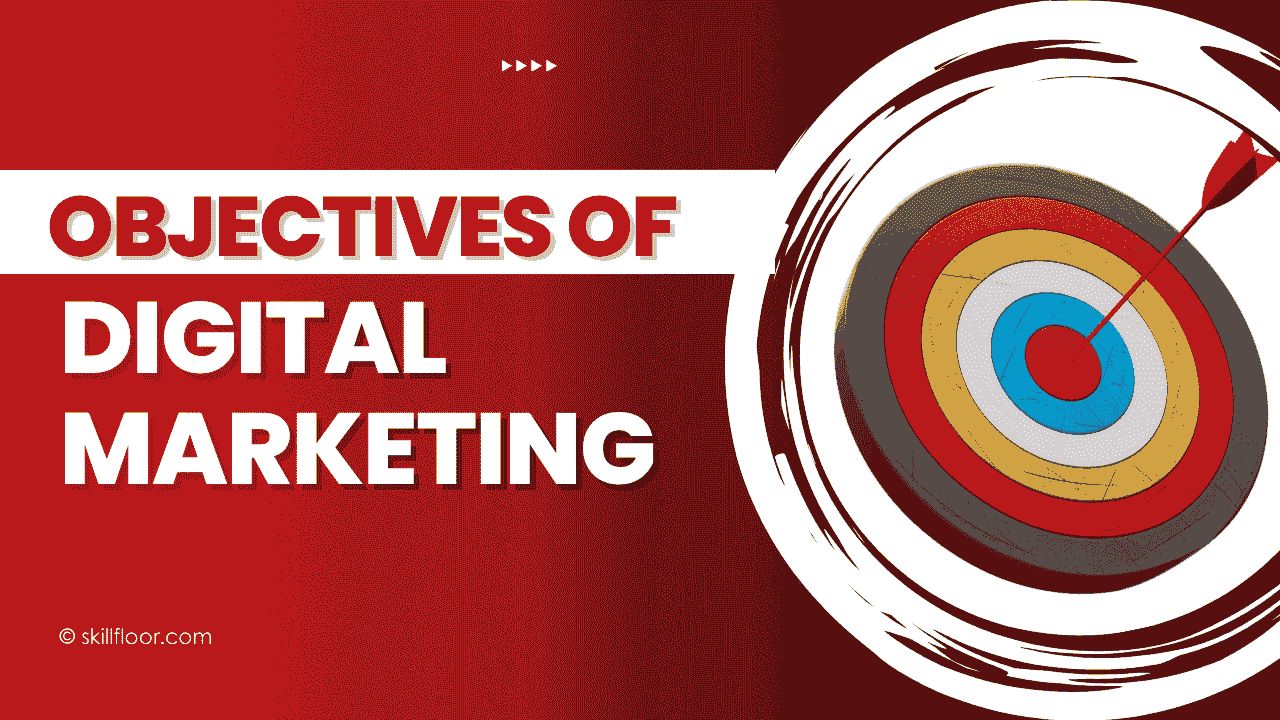What Are the Objectives of Digital Marketing?
The key objectives of digital marketing, include increasing brand awareness, driving traffic, generating leads, and boosting sales effectively.

As a digital marketing expert, I view digital marketing as a focused way to promote products, services, or brands online. It involves using the internet, social media, search engines, and email to connect with people. the objectives of digital marketing vary depending on a company's products, services, and target audience, but they generally include increasing brand visibility, driving website traffic, generating leads, and converting prospects into loyal customers.
What’s great about digital marketing is that it’s based on data. By looking at how people behave and what they like, I can create tailored campaigns that speak to them. This helps us increase brand visibility, attract visitors to our websites, generate leads, and turn prospects into loyal customers.
Challenges in Defining Digital Marketing Objectives
Despite its importance, many businesses struggle with defining clear and actionable objectives for their digital marketing efforts. The complexity of digital platforms, coupled with the vast array of tools and strategies available, can make it challenging to pinpoint exactly what one should aim for. Without a clear understanding of digital marketing objectives, businesses risk misallocating resources, missing out on opportunities, and failing to measure success accurately.
So, what are the core objectives of digital marketing?
1. Benefits of Digital Marketing
Before diving into the objectives, let’s explore why digital marketing is so beneficial:
-
Broader Reach: Digital marketing allows businesses to transcend geographical boundaries. With the Internet, a local business can now reach global audiences, expanding its market and customer base.
-
Cost-Effectiveness: Compared to traditional marketing channels, digital marketing often offers a more budget-friendly approach. Channels like social media, email, and content marketing can deliver significant results without the hefty price tag.
-
Targeted Advertising: One of the biggest advantages is the ability to target specific demographics. Digital marketing enables businesses to reach their ideal customers based on interests, behaviors, and locations, leading to more effective campaigns.
-
Measurable Results: Digital marketing provides detailed analytics, allowing businesses to track performance, measure ROI, and refine their strategies based on data-driven insights.
-
Enhanced Engagement: Platforms such as social media and email marketing offer direct channels for interacting with customers, fostering better engagement and relationship-building.
2. Main Components of Digital Marketing
To understand the objectives of digital marketing, it’s essential to first grasp its main components:
-
Search Engine Optimization (SEO): Enhancing a website’s visibility on search engines to attract organic traffic. This involves optimizing content, improving site structure, and building backlinks.
-
Content Marketing: Creating and sharing valuable content to attract, engage, and convert the target audience. This includes blog posts, videos, infographics, and more.
-
Social Media Marketing: Utilizing social media platforms to build brand awareness, drive traffic, and engage with the audience. It involves creating posts, running ads, and interacting with followers.
-
Email Marketing: Sending targeted emails to nurture leads, retain customers, and drive conversions. This includes newsletters, promotional offers, and personalized messages.
-
Pay-Per-Click (PPC) Advertising: Running paid ads on search engines and social media platforms, where businesses pay for each click on their ads. It’s a way to drive immediate traffic and leads.
-
Affiliate Marketing: Partnering with affiliates who promote your products or services in exchange for a commission on sales or leads generated.
-
Influencer Marketing: Collaborating with influencers to leverage their reach and credibility for promoting products or services.
3. Digital Marketing Objectives
The objectives of digital marketing can vary depending on a business’s goals and industry. However, some common objectives include:
-
Increasing Brand Awareness: One of the primary objectives is to make your brand more recognizable and known to a larger audience. This involves building a strong online presence through various digital channels.
-
Generating Leads: Digital marketing aims to attract potential customers and convert them into leads. This often involves capturing contact information through forms, landing pages, and offers.
-
Driving Website Traffic: Increasing the number of visitors to your website is crucial for generating leads and sales. Strategies like SEO, content marketing, and PPC are commonly used to drive traffic.
-
Boosting Sales: Ultimately, many digital marketing efforts are geared towards increasing sales and revenue. This includes strategies to convert leads into customers and encourage repeat purchases.
-
Enhancing Customer Engagement: Engaging with customers through social media, email, and other channels helps build relationships and improve customer loyalty.
-
Improving Customer Retention: Digital marketing also focuses on retaining existing customers by providing value through personalized content, offers, and ongoing communication.
4. Examples of Digital Marketing Objectives
To make these objectives more tangible, here are some real-world examples:
-
Brand Awareness: A new tech startup might aim to increase its brand visibility by 30% over the next six months through a combination of social media campaigns, influencer partnerships, and content marketing.
-
Lead Generation: An e-commerce company might set a goal to generate 500 qualified leads per month through targeted PPC ads and gated content on their website.
-
Website Traffic: A digital agency could aim to increase organic website traffic by 40% in the next quarter through an SEO overhaul and strategic content marketing.
-
Sales Boost: An online retailer might target a 20% increase in sales over the next year by running seasonal promotions and optimizing their email marketing campaigns.
-
Customer Engagement: A fashion brand could strive to boost social media engagement by 50% over the next three months by running interactive campaigns and engaging directly with followers.
-
Customer Retention: A subscription-based service might aim to reduce churn rate by 15% through personalized email campaigns and improved customer support.
5. Goals of Digital Marketing
The overarching goals of digital marketing align closely with the objectives but often encompass broader strategic targets:
-
Building a Strong Online Presence: Establishing a solid and consistent online identity across various digital platforms.
-
Driving Growth: Using digital marketing strategies to scale operations, enter new markets, and achieve business growth.
-
Enhancing Customer Experience: Providing a seamless and enjoyable online experience for customers through well-designed websites, engaging content, and responsive support.
-
Achieving Competitive Advantage: Leveraging digital marketing to stand out from competitors and capture a larger market share.
6. Digital Marketing SMART Objectives Examples
Setting SMART objectives ensures that digital marketing goals are clear and achievable. Here’s how to apply the SMART criteria:
-
Specific: The objective should be clear and specific. For example, "Increase website traffic by 25%."
-
Measurable: The objective should include criteria for measuring progress. For instance, "Achieve a 25% increase in website traffic, as measured by Google Analytics."
-
Achievable: The objective should be realistic and attainable. For example, "Increase website traffic by 25% within the next six months through targeted SEO and content marketing."
-
Relevant: The objective should align with broader business goals. For instance, "Boosting website traffic will support the goal of increasing brand awareness and generating more leads."
-
Time-bound: The objective should have a clear deadline. For example, "Increase website traffic by 25% within six months."
Examples:
-
SEO Improvement: "Improve organic search rankings for 10 target keywords to reach the top 5 positions within 6 months."
-
Content Marketing: "Publish 12 high-quality blog posts over the next 3 months and achieve a 15% increase in blog traffic."
-
Email Marketing: "Grow the email subscriber list by 20% in the next 4 months through lead magnets and subscription offers."
-
PPC Campaign: "Reduce cost-per-click (CPC) by 10% while maintaining the same level of conversions over the next quarter."
Understanding and setting clear objectives is essential for effective digital marketing. By focusing on specific goals—whether it’s increasing brand awareness, generating leads, driving traffic, or boosting sales—businesses can better align their strategies and measure success. With the right mix of digital marketing components and SMART objectives, you can harness the power of digital marketing to achieve your business goals and drive growth. As someone deeply involved in the field, I can attest to the impact that well-defined objectives can have on your digital marketing efforts. So, take the time to establish your objectives and watch your digital presence thrive.




























































